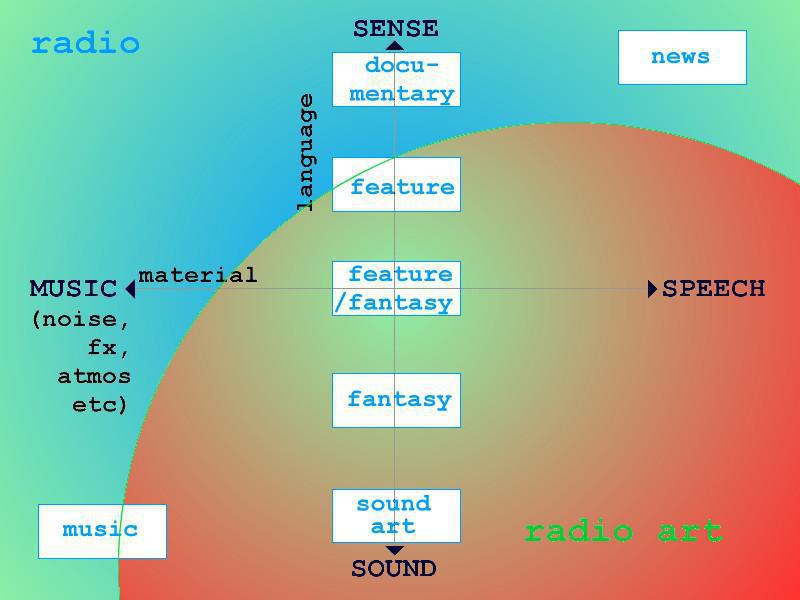When is a piece of radio a piece of radio art?
Once upon a time I made a number of radio programmes (almost all for BBC Radio 3) not easily categorised as ‘normal’ speech or music programmes. That’s not my view – Bayan Northcott wrote in The Independent:
“At present, Radio 3 music documentaries seem to fall into three categories; programmes about music, programmes around music, and programmes produced by Antony Pitts...”
Producing any radio programme is somewhat like composing a piece of music – you make a large number of decisions about timing, balance & material, and structure the whole in an attempt to communicate to the listener. Unlike a traditional piece of Western music – where (to generalise) the material is conceived as an abstract collection of pitches and durations to be realised in performance – a piece of radio is made up of secondary, already concrete material such as music samples, noise, effects, speech, and atmospheres (train stations etc). These are extreme definitions – the reality is more blurred: most pieces of music (especially today’s computer-assisted creations) contain many clichés or pre-existent material which has been found and incorporated, knowingly or unknowingly; and of course, most radio programmes contain specially-authored material. When the number of creative decisions about time, dynamic and choice of acoustic material becomes incalculable, and the involvement and identification of the individual with their product almost total, the demarcation between composing and producing becomes virtually meaningless.
“...Where this creative ingenuity has fed back into his broadcast features... ...the resulting multi-tracked and cross-faded collages of music, speech and directional sound have proved some of the most intricate and evocative in recent radio..." The Independent (11 December 1998)
All radio programmes communicate in a combination of two languages – ‘sense’ & ‘sound’ – using two kinds of material ordinarily associated with those languages – speech & music. Extreme examples might be on the one hand, a news programme (just speech – no music, effects, or actuality) that makes straightforward narrative ‘sense’; and on the other hand, a music-only programme (a sequence of music with no presentation) that communicates purely in ‘sound’. In fact, news programmes often do use sonic effects and location recordings to colour the narrative; and music programmes are usually structured so that they refer to a theme that can be verbalised (such as the “pain of love”) or to make a point about chronological/geographical comparisons. And of course, ‘sense’ & ‘sound’ are terms with a multiplicity of meanings – I am using them crudely here to distinguish between what others have called ‘left brain’ & ‘right brain’:
“...there appear to be two modes of thinking, verbal and nonverbal, represented rather separately in left and right hemispheres [of the brain] respectively...” Roger Sperry (1973)
My experience is that speech and music can each also communicate in the language of the opposite polarity: the sonic qualities of speech speak to us where there is little or no linear narrative to be followed and/or audibility is reduced by layering; music (including noise, effects etc) can narrate events or provide a commentary by association in a way that can be analysed semantically. The more the material is used to create and reinforce a verbal narrative, the closer the whole resembles a radio documentary; the more the material (both speech and music) is used nonverbally, the closer it approaches ‘pure’ sound art or radiophony – or what one might simply call music (given its expanded 20th/21st-century definition).
But sound art is only a part of a larger and potentially more complicated area of creativity termed here - for want of a better description – as radio art (which itself is part of the universal set of anything that can be broadcast). I suggest that radio art also includes three intermediate types of programmes which – in order to provide some gradation to what is essentially a continuum – I have arbitrarily named, and placed on the vertical axis of the diagram above.
The feature is clearly about something or other (like a ‘documentary‘), but the narrative may not be completely linear or continuous, and the materials are selected and exploited at least partly for their sonic qualities...
The feature/fantasy is ostensibly on a theme or single subject (like a ‘feature’), but often without a clear narrative and highly-coloured by the juxtaposition and superimposition of materials; here the sound and the ordinary verbal meaning of words and musical events are finely-balanced...
The fantasy is often a bringing together of several stated and unstated themes, linked by more dreamlike associations, where linear narrative is the exception rather than the rule, and things happen because they just sound good...
Anyway, see (or rather hear) what you think (authorized listeners only) – what is Radiophonic, and what is a Documentary? Some programmes are just Special... If you don't have research access, there are a half a dozen Trails available!
Antony Pitts
Golden Radio


